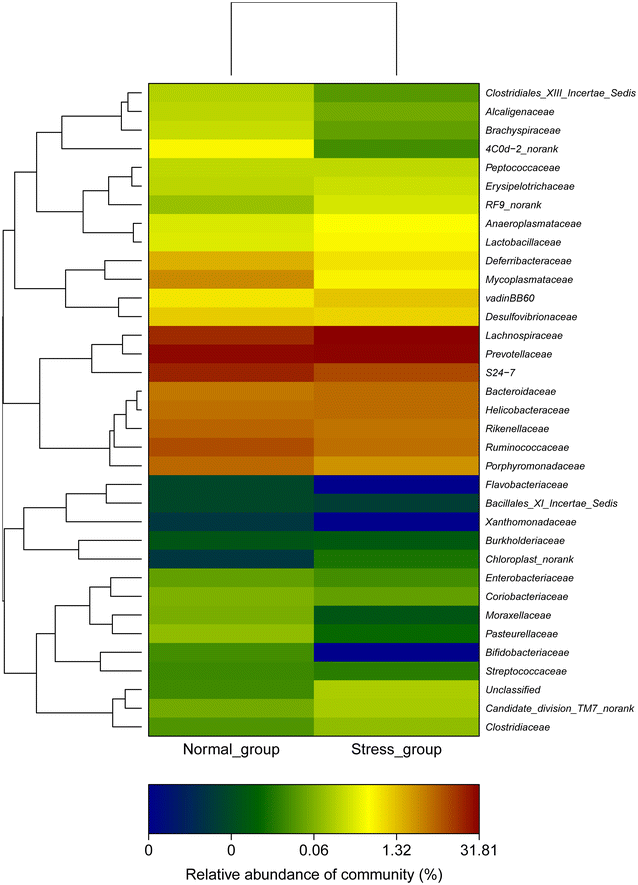Lachnospiraceae shift in the microbial community of mice faecal sample effects on water immersion restraint stress
- PMID: 28417435
- PMCID: PMC5393979
- DOI: 10.1186/s13568-017-0383-4
Lachnospiraceae shift in the microbial community of mice faecal sample effects on water immersion restraint stress
Abstract
Stress, including both psychological and physical stimulation, can cause changes in the microbiota and mucosal function of the gastrointestinal system. There are few research studies available about the faecal microbiota changes after stress, such as water immersion restraint stress (WIRS). Therefore, in this study, we focused on analysing the composition changes of faecal microbiota in WIRS mice. The WIRS model, in which Blab/c mice were immersed in 21 ± 2 °C water for 4 h each day for 14 days, was established. Behavioural changes, the serum levels of corticosterone, IFN-γ and IL-17 and gastric mucosal injury were also assessed. Ten faecal microbiota samples were detected by Illumina Miseq sequencing of the 16S rRNA genes from 367205 characterised sequences. Finally, we find significant differences in the faecal microbiota composition between the control and the WIRS groups. There was an obvious increase in Lachnospiraceae in the WIRS mice (p = 0.0286, p < 0.05), which is associated with human diseases, such as ulcerative colitis, Crohn's and celiac disease. Our research indicates that stress changes in the faecal microbiota. These results suggest that observing shifts of the intestinal microbiota is a promising method to explore the mechanism of the stress associated with gastrointestinal diseases and to provide us with a better understanding of the relationship between the microbiota and disease.
Keywords: 16s rRNA; Faecal microbiota; Illumina Miseq sequencing; Microbial community; Water immersion restraint stress.
Figures







Similar articles
-
Sinisan ameliorates colonic injury induced by water immersion restraint stress by enhancing intestinal barrier function and the gut microbiota structure.Pharm Biol. 2023 Dec;61(1):598-609. doi: 10.1080/13880209.2023.2191643. Pharm Biol. 2023. PMID: 37013944 Free PMC article.
-
The Protective Effect of Polysaccharide SAFP from Sarcodon aspratus on Water Immersion and Restraint Stress-Induced Gastric Ulcer and Modulatory Effects on Gut Microbiota Dysbiosis.Foods. 2022 May 26;11(11):1567. doi: 10.3390/foods11111567. Foods. 2022. PMID: 35681318 Free PMC article.
-
Betaine attenuates memory impairment after water-immersion restraint stress and is regulated by the GABAergic neuronal system in the hippocampus.Eur J Pharmacol. 2017 Feb 5;796:122-130. doi: 10.1016/j.ejphar.2016.12.007. Epub 2016 Dec 7. Eur J Pharmacol. 2017. PMID: 27940054
-
Comprehensive fecal metabolomics and gut microbiota study of the protective mechanism of herbal pair Polygonum hydropiper-Coptis chinensis in rats with stress-induced gastric mucosal damage.Front Pharmacol. 2024 Aug 13;15:1435166. doi: 10.3389/fphar.2024.1435166. eCollection 2024. Front Pharmacol. 2024. PMID: 39193339 Free PMC article.
-
Analysis of the Intestinal and Faecal Bacterial Microbiota of the Cervidae Family Using 16S Next-Generation Sequencing: A Review.Microorganisms. 2023 Jul 24;11(7):1860. doi: 10.3390/microorganisms11071860. Microorganisms. 2023. PMID: 37513032 Free PMC article. Review.
Cited by
-
The Impact of Instant Coffee and Decaffeinated Coffee on the Gut Microbiota and Depression-Like Behaviors of Sleep-Deprived Rats.Front Microbiol. 2022 Feb 25;13:778512. doi: 10.3389/fmicb.2022.778512. eCollection 2022. Front Microbiol. 2022. PMID: 35283829 Free PMC article.
-
The Mediating Role of Plasma Inflammatory Proteins in Gut Microbiota-Driven Valvular Heart Disease: A Mendelian Randomization Study.Cell Biochem Biophys. 2025 May 28. doi: 10.1007/s12013-025-01780-9. Online ahead of print. Cell Biochem Biophys. 2025. PMID: 40425948
-
Melatonin-Microbiome Two-Sided Interaction in Dysbiosis-Associated Conditions.Antioxidants (Basel). 2022 Nov 14;11(11):2244. doi: 10.3390/antiox11112244. Antioxidants (Basel). 2022. PMID: 36421432 Free PMC article. Review.
-
Influence of Gut Microbiota on Progression to Tuberculosis Generated by High Fat Diet-Induced Obesity in C3HeB/FeJ Mice.Front Immunol. 2019 Oct 18;10:2464. doi: 10.3389/fimmu.2019.02464. eCollection 2019. Front Immunol. 2019. PMID: 31681334 Free PMC article.
-
Causal Associations between Gut Microbiota and Different Types of Dyslipidemia: A Two-Sample Mendelian Randomization Study.Nutrients. 2023 Oct 20;15(20):4445. doi: 10.3390/nu15204445. Nutrients. 2023. PMID: 37892520 Free PMC article.
References
-
- Amato KR, Yeoman CJ, Kent A, Righini N, Carbonero F, Estrada A, Gaskins HR, Stumpf RM, Yildirim S, Torralba M, Gillis M, Wilson BA, Nelson KE, White BA, Leigh SR. Habitat degradation impacts black howler monkey (Alouatta pigra) gastrointestinal microbiomes. ISME J. 2013;7(7):1344–1353. doi: 10.1038/ismej.2013.16. - DOI - PMC - PubMed
LinkOut - more resources
Full Text Sources
Other Literature Sources

